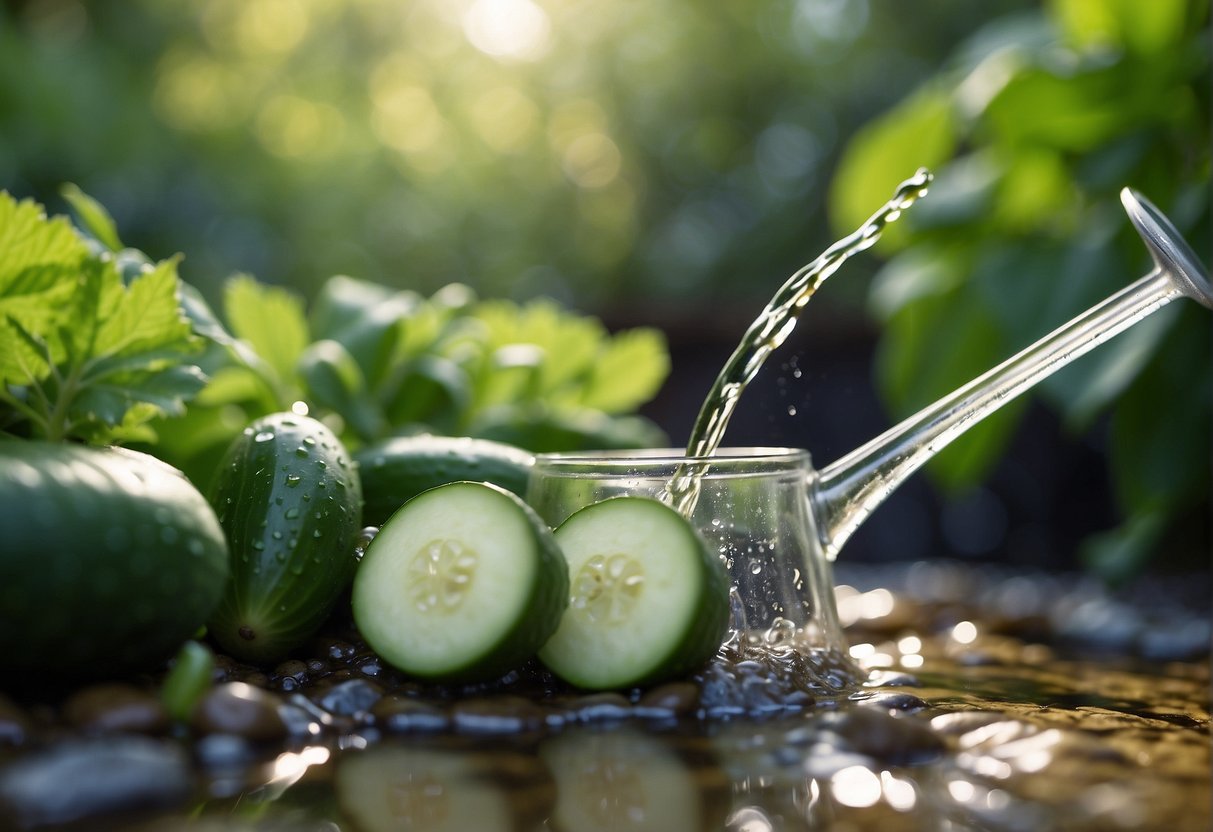Watering cucumber plants properly is vital for their growth and fruit production. As someone who has experience in gardening, I can tell you that cucumbers, with their sprawling vines and lush foliage, are not only a staple in many kitchens but also a popular choice for gardeners looking to grow their own vegetables. The frequency of watering these plants is crucial, as both underwatering and overwatering can lead to issues that affect plant health and yield.

During the seed germination stage, daily watering is essential to keep the soil moist. This helps the seedlings establish a strong root system. As the plants grow, the watering needs shift. Cucumber plants have a shallow root system which makes them sensitive to changes in soil moisture levels. Therefore, consistent and adequate watering is key to healthy plant development and successful cucumber production.
I find that mature cucumber plants generally need about 1 to 2 inches of water per week, but this can vary depending on factors like soil type, climate, and plant size.
JUMP TO TOPIC
Optimizing Soil and Watering Conditions for Cucumber Plants
Effective cultivation of cucumbers hinges on the delicate balance between soil composition and irrigation practices tailored to the plant’s needs.
Balancing Soil Moisture and Drainage
I am attentive to soil moisture levels, ensuring they remain consistent for cucumber health.
Cucumbers thrive in moist, well-drained soil. I check the soil regularly by touching it; if the top inch is dry, I water my plants. To maintain a balance, I use mulch, which helps retain moisture and reduces the frequency of watering.
Adjusting Watering Habits to Climate and Weather
I adapt my watering schedule to the whims of the weather. On average, cucumbers require:
- 1 inch of water per week in moderate conditions
- Twice per day when temperatures exceed 90°F
In regions with high heat and low rainfall, I increase the frequency and monitor for signs of thirst, such as wilting or dull foliage.
Choosing the Right Soil Type and pH
The ideal soil for cucumbers is loamy, rich in organic matter, with a pH of 6.0 to 6.8. I incorporate compost to improve fertility and structure, allowing for better root growth and water penetration.
💥 Soil Texture Importance
Coarse soils may require more frequent watering due to rapid drainage, whereas clay soils, which retain water longer, might need less. Adjusting the soil mixture and pH is a vital step I take for my cucumbers to ensure they receive adequate nutrients and water.
Preventing Overwatering and Underwatering
Ensuring that cucumber plants receive the right amount of water is pivotal for their health and yield. I’m going to share effective strategies to prevent both overwatering and underwatering, which are key to cultivating robust cucumber plants.
Identifying Signs of Overwatering and Underwatering
Overwatering: Cucumber plants will have leaves that are yellowing and wilted, with new growth appearing mushy or limp. Root rot could occur, featuring roots that are brown and soft instead of white and firm.
Underwatering: Plants will display drooping leaves that feel dry to the touch, and the growth of cucumbers may be stunted or deformed. Soil moisture will be low, and the plant may not recover its turgidity even in the cooler evening hours.
Irrigation Techniques to Maintain Consistent Moisture
In my experience, maintaining consistent soil moisture is critical for cucumber plants. I recommend using drip irrigation systems or soaker hoses, which provide slow, deep watering directly to the roots and minimize evaporation. This method prevents water wastage and keeps foliage dry, reducing the risk of disease.
| Technique | Benefits | Considerations | Frequency |
|---|---|---|---|
| Drip Irrigation | Targeted, efficient watering | Initial setup cost | Adjustable |
| Soaker Hoses | Even distribution, less labor | Can be obscured by foliage | Regular intervals |
| Deep Watering | Encourages deep root growth | Requires careful monitoring | Less frequent, thorough soak |
Monitoring soil moisture levels is essential. I tend to water when the top inch of soil feels dry. The watering frequency may vary due to temperature and rainfall, but generally, I aim for 1 to 2 inches of water per week. During hot weather or if cucumbers are grown in containers, checking daily may be necessary. Always avoid watering in the heat of the day to reduce evaporation and stress on plants.
Protecting Cucumbers from Pests and Diseases
Caring for cucumbers requires a proactive approach to preventing diseases and managing pests. Proper watering and maintaining plant health are key to warding off common issues.
Effective Watering to Prevent Diseases
Overwatering can contribute to the development of fungal diseases like root rot and powdery mildew in cucumbers. To avoid excessive leaf wetness, I water my plants at the base and early in the morning, allowing the sun to dry the foliage throughout the day. This method minimizes the conditions that favor fungal growth, such as prolonged dampness on leaves. I also ensure to water deeply but infrequently to encourage robust root systems, which are less susceptible to diseases.
Avoid keeping the soil wet continuously as it can lead to root rot and weaken the plants, making them more prone to diseases.
Combating Common Cucumber Pests and Diseases
My experience with cucumbers has taught me that common pests, such as cucumber beetles and aphids, as well as diseases like powdery mildew and yellowing leaves, can be largely prevented with the right tactics. I practice regular inspection and remove any infected plants to prevent the spread. I also prefer using organic pest control methods; introducing beneficial insects, such as ladybugs, can naturally reduce pest populations. For diseases such as mildew, crop rotation and resistant varieties are effective preventive measures. If any yellowing of leaves occurs, it is often a sign of nutrient deficiency or disease, which I tackle by adjusting the soil nutrients and removing affected leaves when necessary.
Plant resistant cucumber varieties and consider crop rotation to naturally reduce disease risks and maintain soil health.












